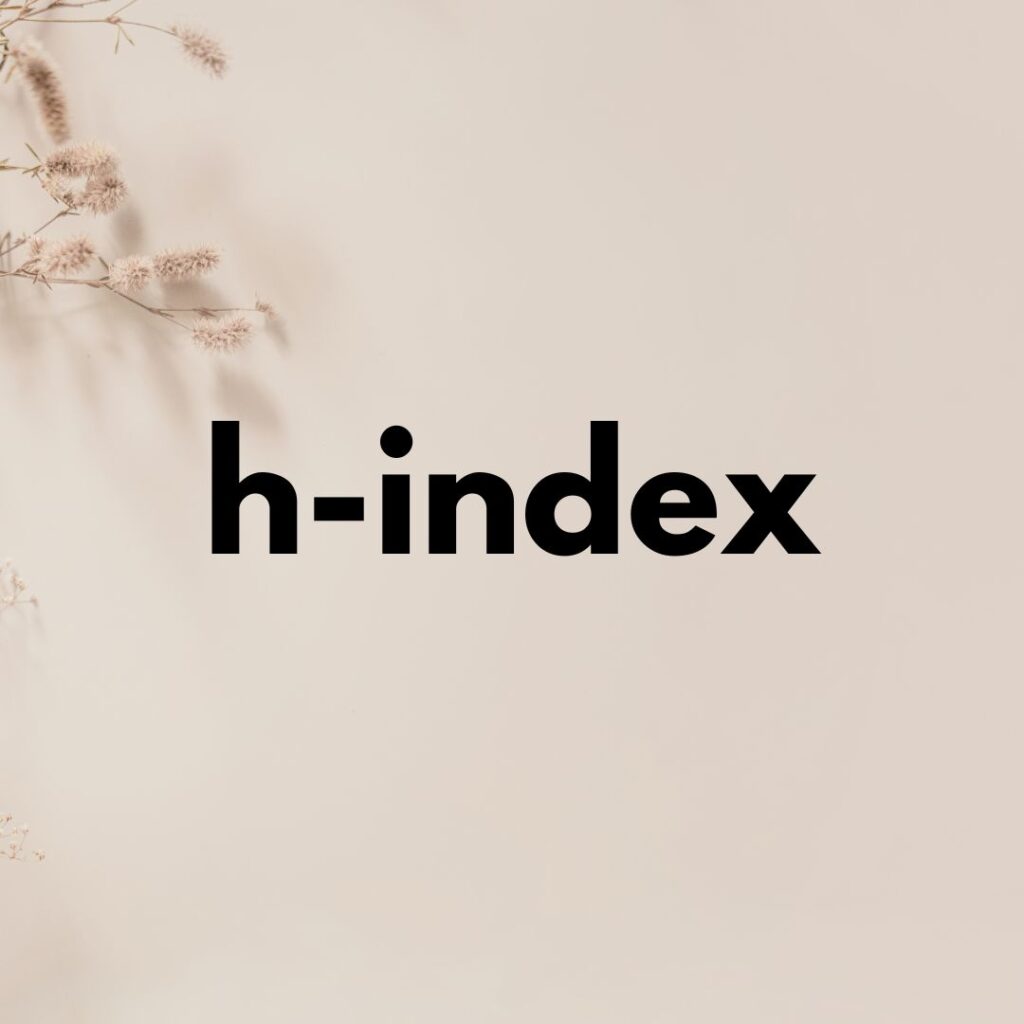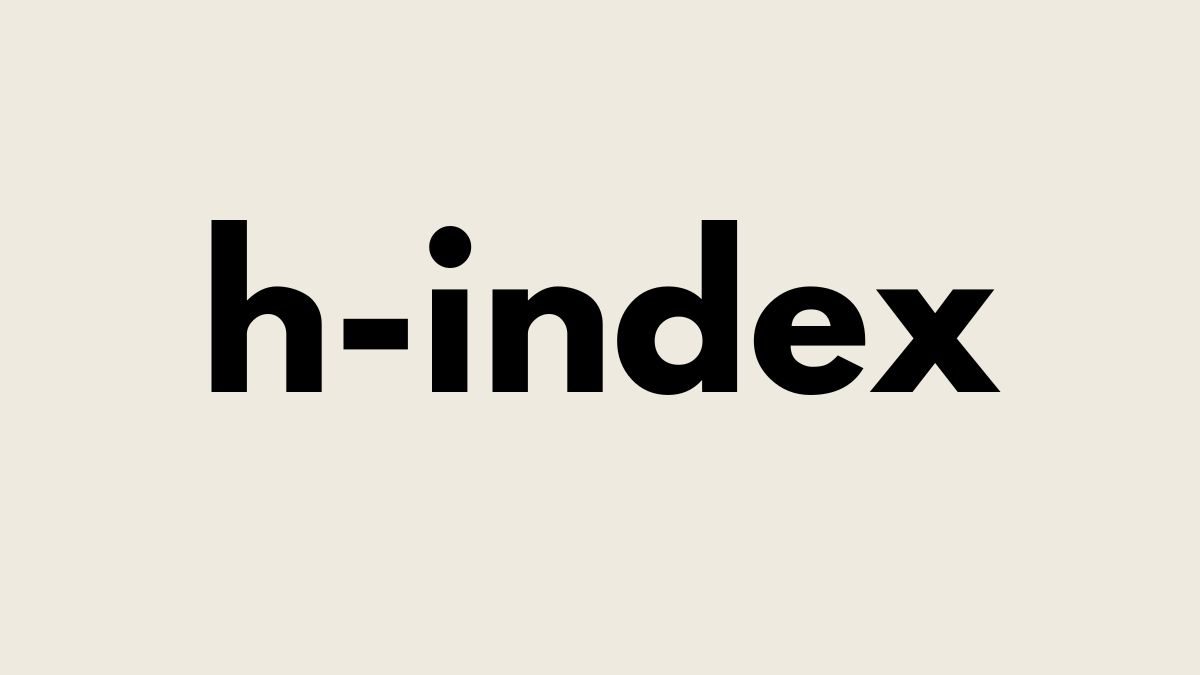Table of Contents
- Introduction to the h-Index
- What is the h-Index?
- The History and Evolution of the h-Index
- Why is the h-Index Important?
- Criticisms and Limitations of the h-Index
- How to Improve Your h-Index
- Conclusion
Introduction to the h-Index
The h-index is a popular and credible metric quantifying an academic researcher’s scientific productivity and impact.
As academic careers become increasingly competitive, metrics like the h-index have become more important. They help quantify a researcher’s influence in their field and can impact everything from hiring and promotion decisions to research funding opportunities.
For this reason, it’s valuable for scholars across all disciplines to understand the h-index and how it works.
In this introductory section, we’ll briefly cover the fundamentals of the h-index and discuss why it has become such an influential gauge of scholarly success. In later sections, we’ll also touch on some of the index’s limitations and set the stage for a more in-depth exploration.

While the h-index has flaws, it provides a useful starting point for assessing research impact. By learning about this popular metric, scholars can better understand how their work is perceived and find ways to increase their academic influence over time.
What is the h-Index?
The h-index is a metric used to quantify an academic researcher’s scientific productivity and citation impact. It is calculated based on the researcher’s most cited papers and the number of citations they have received.
Specifically, a researcher has an h-index of N if N of their papers have at least N citations. For example, if a researcher has five publications with at least five citations each, their h-index would be 5.
To calculate the h-index, first order a researcher’s publications by the number of citations, with the most cited paper listed first. Going down the list, find the point at which the ranking number exceeds the number of citations. That ranking number is the h-index. Several online databases, such as Scopus and Web of Science, can automatically calculate an author’s h-index.
The h-index considers the number of publications and their citation impact. It favors researchers who publish influential work consistently rather than those with many low-impact publications or a few highly-cited papers. The h-index can apply to all scholarly works, including journal articles, conference proceedings, books, patents, and software products.
One key advantage of the h-index is combining productivity (number of papers) and impact (citations) into one simple metric. However, it has limitations in accurately comparing scholars across disciplines or career stages. Various variations of the h-index have been proposed to address some of these limitations.
The History and Evolution of the h-Index
The h-index was first proposed in 2005 by Jorge E. Hirsch, a physicist at the University of California, San Diego. Hirsch developed the index to quantify an individual researcher’s scientific productivity and impact.
According to Hirsch, the h-index was needed because metrics like publication count, citations, and Journal Impact Factor had shortcomings when evaluating a researcher’s output. The h-index aimed to provide a more balanced and comprehensive picture.
In his original paper, Hirsch demonstrated that h-index values could effectively predict whether a scientist would win prestigious awards like the Nobel Prize. This evidence of the h-index’s validity helped it gain traction after being introduced.
The h-index has become widely adopted in the years since, especially in the natural and physical sciences. In addition to being included in major citation databases, the h-index has expanded beyond individual researchers to measure the impact of journals, research groups, and institutions.
Some key evolutions of the h-index include:
- The introduction of the contemporary h-index to account for the age of publications.
- Variations like the g-index and e-index to address the limitations of the original metric.
- The creation of field-specific h-index thresholds to better assess impact.
While criticisms exist, the h-index remains highly influential in assessing scholarly impact today. It is often considered in grant funding, academic appointments, and tenure review processes.
Why is the h-Index Important?
The h-index has become crucial for assessing research impact and scholarly influence. This single number provides a convenient way to quantify a researcher’s scientific contributions and compare their productivity against peers. There are several key reasons why the h-index has gained such prominence in academia and research:
Career Advancement
A high h-index is often viewed favorably for hiring, promotion, and tenure decisions at universities and research institutions. Candidates with a robust h-index tend to be perceived as more accomplished and influential. The h-index provides hiring committees and administrators with an ostensibly objective measure to evaluate applicants and make decisions on advancement.
Funding Opportunities
Research grant agencies and foundations increasingly consider the h-index when making funding decisions. Applicants with a higher h-index may be deemed more productive and have an enhanced chance of securing grants.
Recognition and Visibility
A high h-index helps confer prestige and name recognition in one’s field. Researchers with a substantial h-index are often invited to serve on editorial boards, speak at conferences, and participate in collaborations. Younger scholars may benefit from a strong h-index to gain visibility and establish themselves in their discipline.
The h-index provides a simple yet influential way to gauge productivity and impact. Researchers aiming for career advancement, funding, and recognition cannot afford to ignore their h-index. Proactively monitoring and improving one’s h-index is key to success in today’s competitive academic environment.
Criticisms and Limitations of the h-Index
While the h-index has become a widely used metric for assessing scholarly impact, it is not without its criticisms and limitations.
Some of the main concerns regarding the h-index include:
Potential Biases
The h-index can be biased towards more senior researchers with longer careers. It also tends to favor researchers who publish a steady stream of papers rather than those who publish infrequently but have a few very high-impact papers. Some fields, such as mathematics and humanities, tend to have lower h-indices on average compared to fast-moving fields like biomedicine.
Inaccuracy
The h-index does not account for the context of citations or measure their quality. Self-citations and negative citations are counted the same as normal citations.
Co-authored papers are treated the same as single-author papers, so the h-index may not accurately represent an individual’s contribution. There are also variations in citation patterns between disciplines.
Gameability
It is possible for researchers to deliberately game the h-index system if they understand how it works. For example, coordinating self-citations with colleagues can artificially inflate one’s h-index. Another strategy is publishing many review articles, which tend to be highly cited.
Delayed Recognition
Since the h-index is citation-based, a significant delay can occur before a researcher’s best work is properly recognized. Important papers often take years to accumulate citations so younger researchers may have h-indices below their true scholarly potential.
Field Dependence
The h-index is highly dependent on the academic field, making it difficult to compare disciplines. For instance, physics papers have far more authors and citations than humanities papers. So a physics h-index of 20 does not indicate the same level of impact as a humanities h-index of 20.
While the h-index is a useful metric, it should be considered alongside other qualitative and quantitative ways of evaluating scholarly influence. The h-index is best utilized as a part of a holistic review process rather than a standalone number for hiring, promotion, and funding decisions.
How to Improve Your h-Index
As a researcher, you can use several practical strategies to increase your h-index over time. The most direct approach is to publish more high-quality papers in reputable peer-reviewed journals.
The higher the impact factor of the journals you publish in, the more citations your work will likely receive, boosting your h-index. Submitting to open access journals can also increase your publications’ visibility and citation rate.
You should aim to publish regularly, as a steady output of papers helps maintain momentum. Avoid publishing too many papers in a short burst, which can dilute their impact. It’s better to space out your publications over months or years. Collaborating with other scholars can also lead to more co-authored papers and citations.
In addition to publishing, you can take steps to promote your published work. Share links to your papers on academic social media platforms like ResearchGate and Academia.edu.
Use sites like Google Scholar to create a public author profile and list all your papers in one place. Consider writing review articles or opinion pieces to synthesize research in your field – these tend to be well-cited. Give presentations at conferences and seminars to reach more researchers.
It’s important to monitor your h-index periodically through citation databases so you can track your progress. Set realistic goals for increasing your h-index over a set timeframe, such as going from 10 to 15 in two years. As you approach retirement, your h-index will naturally plateau, so it’s best to focus on increasing it during your early and mid-career stages.
While self-promotion is important, the best way to improve your h-index long-term is to conduct groundbreaking research and produce high-quality publications. Your work must be significant and impactful to attract high peer citations.
Conclusion
As we have seen, the h-index is a crucial metric for assessing scholarly influence and impact in academia and research. Though not perfect, the h-index provides a simple way to quantify an individual researcher’s productivity and citation impact over their career.
Let’s recap some key takeaways:
- The h-index balances an author’s number of publications and the number of citations per publication, making it a useful single-number metric of scholarly influence.
- A higher h-index generally correlates with greater prestige and recognition in a researcher’s field.
- The h-index can be valuable for career advancement, hiring, promotion, and grant funding decisions.
- There are limitations to the h-index, so it should not be used as the sole measure of impact.
- Strategically publishing in high-impact journals, promoting your work, and accumulating citations over time can help boost your h-index.
Consider supplementing the h-index with metrics like citation counts and usage or social media metrics. No one number can capture the multidimensional nature of academic influence. Use a combination of quantitative and qualitative measures to showcase your scholarship from different angles.
